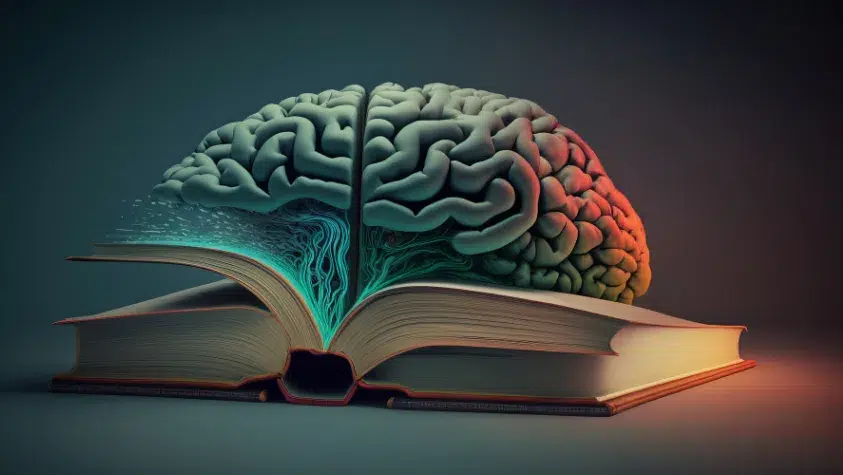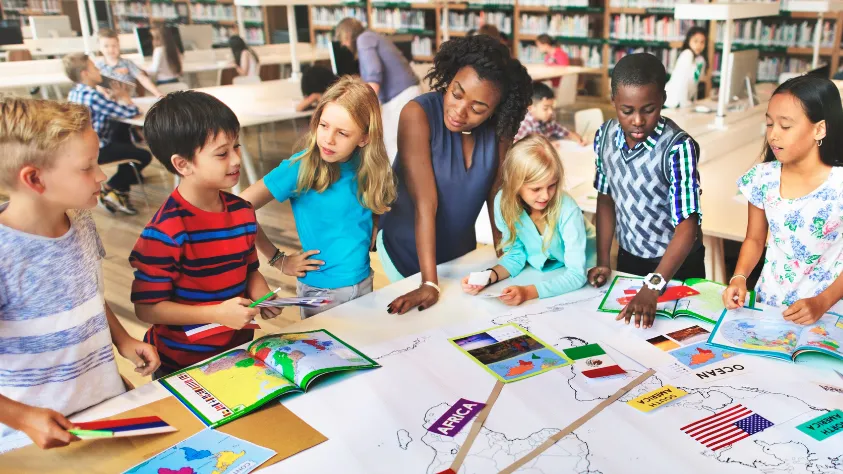
The school of tomorrow: how neuroscience is reinventing learning for our children

Thanks to dazzling advances in neuroscience and a host of innovative teaching experiments being conducted in schools, we’re witnessing a veritable revolution in the way we teach our dear little ones. 📚
Between serious games and alternative learning systems, neuroscientists and their incredible discoveries are starting to shake up classroom habits.
Curious to discover what tomorrow’s school has in store for your little ones? Discover Arte’s fascinating documentary “Demain l’école“, divided into two parts, the trailers for which are below.
Tomorrow’s schools, innovations around the world (part 1)
Tomorrow’s school: making good use of the brain (part 2)
Need a condensed, commented version of this excellent compendium of information? Babaoo Mag has you covered! ⬇️
Neuroeducation, or how to rethink school 💡
Neuroeducation is a new way of thinking about education, combining insights from various scientific fields to enrich our children’s learning:
- Cognitive sciences: they explore how thought is formed and developed. They help us understand how children process information, make decisions and solve problems.
- Neuroscience: this discipline focuses on how the brain works. It explores the biological and chemical mechanisms that orchestrate our mental and behavioral processes, essential to understanding learning.
- Educational sciences: these focus on identifying the most effective teaching strategies, based on an in-depth understanding of learning processes.
The aim of neuroeducation is to decipher what goes on in children’s brains when they are learning, whether in the classroom, doing homework or experimenting with new things. By understanding these processes, we can adapt our teaching methods and make education more effective and more in tune with students’ cognitive needs.
The four pillars of neuroeducation
In its quest to transform our children’s education, neuroeducation is based on four fundamental pillars identified by renowned neuroscientist Stanislas Dehaene: Attention, Active Engagement, Error and Consolidation. Let’s explore together how these pillars can be effectively and innovatively integrated into the education of our young learners! 🧑🏫
Attention: perform simple tasks to improve concentration 🎯
A neighbor who’s a little too chatty, a cat passing by outside, laughter and bursts of voices from the classroom opposite… So many distractions that put our children’s ability to stay focused to the test!
Let’s face it, our children’s ability to concentrate often seems as short-lived as the circuit of the Maurice fish in its jar! 🐟 Yet Attention is a necessary capacity to capture and retain essential information, by listening to the teacher rather than chatting with his classmate.
In young children, Attention is still underdeveloped because it depends on the prefrontal cortex, the brain region that orchestrates a wide range of cognitive functions linked to learning, and which continues to evolve and mature into adulthood.
✏ Note: Attention plays a transversal and fundamental role in the cognitive development of young minds. A good attentional capacity enables the child to reinforce and develop other Executive Functions more easily, such as:
- Inhibition control: helps the child to resist distractions, such as peer chatter, and focus on the essentials of learning.
- Working Memory: enables the child to retain and follow instructions or directions needed to complete a task, a crucial skill in the learning process.
- Planning: helps the child organize and prioritize tasks, promoting methodical and efficient execution.
Although it may seem simple, maintaining sustained Attention and developing these Executive Functions is actually a complex challenge for children who are constantly asked to listen, understand, and store information throughout the day. 🤯
Active engagement: getting involved for better memorization
You’ve probably already heard of dopamine, the pleasure hormone that activates what’s known in the brain as the “reward circuit“. But did you know that it also directly influences the hippocampus, a brain area essential for long-term memorization? 🧠
Neuroscience research reveals that a child who actively participates in learning – touching, talking, creating – stimulates the release of dopamine. This activation not only engenders greater curiosity, but also significantly improves learning capacity. In other words, when children are rewarded with this dopamine release, their learning becomes deeper and more enduring.
🔎 The Creil Savanturiers study
Since 2013, a primary school class in the Oise region has embarked on an innovative project called “Les Savanturiers“, aimed at awakening and developing pupils’ curiosity.
The idea: to enable children to take part in group projects, where they can play the role of little scientific researchers and study a theme – in this case, the intelligence of crows. This immersion in scientific research, by continually arousing their curiosity, leads them to actively question the behavior of these fascinating birds.
Here again, the results of this participatory approach are striking. Not only do the children show a significant improvement in their ability to memorize, but they also develop advanced skills in critical thinking and retrieving acquired information.
Mistakes for better retention
How many times have you heard: “To err is human!“, “It’s normal, anyone can make a mistake!“… Except that when it comes to learning, making mistakes isn’t just normal: it’s a source of information! See “The differents types of mistakes“.
When the brain detects a mistake, it doesn’t just acknowledge failure. It begins an active process of readjusting neural networks. This is how we learn not to make the same mistakes, whether in simple everyday situations or in more complex learning contexts.
It’s also crucial to understand that identifying the type of error can provide valuable information about the nature of that error. For example, an error may be the result of a lack of understanding, a lack of motivation or other factors. By recognizing and understanding the error, we can better respond to the specific needs of each learner. So, the next time you hear an “Oops!”, rest assured, it’s a good sign!
🔎 Study on the role of error in learning
An American study carried out in 2008 highlighted the crucial role of error in learning. Two groups of students were asked to memorize a textbook: the first group focused exclusively on studying the content, while the second alternated between memorization sessions and quizzes.
The results were surprising: despite a shorter overall study time, the students who took part in the quizzes performed better. The reason? The members of the first group, although they felt they had mastered the subject, only called on their Working Memory. The quizzes enabled members of the second group to detect and correct their errors, facilitating true integration of the knowledge into their long-term memory.
💡 Babaoo’Tip:
To optimize home study, incorporate quizzes into your child’s revision program. Fifteen minutes of studying, fifteen minutes of testing! You’ll soon see the power of error on your little savant’s memory! 🤓
Consolidation: sleep to better assimilate information
The final pillar of learning: consolidation. Neuroscience tells us that, in the brain, synapses – the connections between neurons – are strengthened by repetition. Conversely, connections that are little used tend to weaken and may even disappear.
🧮 Consolidation is essential to learning, because it creates automatisms. For example, if you’re asked how much 2+2 is, you’ll probably stop counting on your fingers… That’s thanks to consolidation! You no longer calculate; the answer has become automatic.
The same goes for reading: your brain is so used to deciphering words that it hardly thinks at all. That’s why you’re able to read this pshrae, even if the letters aren’t in the right order!
This Consolidation process is particularly active during sleep, when the brain sorts, organizes and reinforces the day’s learning. Thus, quality sleep is essential for effective consolidation of learned information, promoting better retention and understanding over the long term.
At the same time, it’s interesting to consider the forgetting curve. Forgetting is a natural mechanism put in place by the brain to eliminate information deemed superfluous. Without regular review and practice, even important information can be lost. The magic formula for overcoming forgetfulness? Reactivation + deepening! ✅
🔎 Studies on the role of sleep in learning
Since the early 2000s, neuroscientists have been highlighting the crucial influence of sleep on the consolidation of learning. Moreover, studies converge to emphasize that a simple nap can significantly boost students’ learning abilities. 💤
Thanks to advances in brain imaging, it has been observed that during sleep, the brain is the scene of intense activity. It seems to revisit and integrate experiences and information acquired during the day, thus promoting their consolidation. Some studies even suggest that better sleep hygiene could reduce attention deficit disorders in children, highlighting the vital role of quality sleep for cognitive development.
Shaping tomorrow’s schools through neuroeducation
Discoveries in neuroscience are gradually beginning to influence teaching methods. By deepening our understanding of children’s cognitive processes, we are adapting education to make it more effective and sustainable. It now seems clear that, in order to learn, we must first… learn how to learn!
Take the example of Finland, where some schools have introduced 4-hour school days, incorporating activities such as cooking, painting and carpentry. These programs encourage students to cultivate their creativity, autonomy and empathy, while progressing at their own pace.
In Singapore, 20% of the national budget is devoted to teacher training! There’s also a method of learning math called the “Singapore Method”, which is increasingly used in Europe, and involves teaching maths by gradually moving from the concrete to the abstract, rather than memorizing concepts by heart.
In France and Belgium, too, neuroscientists are stepping up their efforts in neuroeducational research. They are designing and testing a variety of educational games designed to enhance learning in reading, mathematics and science. These games, and other innovative programs such as Atole, Poppins and Inemo, are designed to stimulate children’s cognitive abilities, helping them to develop their intellectual “superpowers”. 🦸
Babaoo recap!
Attention, Active Engagement, Error Recognition and Consolidation: these pillars, highlighted by neuroscientific research and in particular by the work of Stanislas Dehaene, pave the way for revolutionary advances in our understanding of children’s cognitive development. And the potential of these discoveries seems almost limitless!
It’s hard to know today what tomorrow’s school will look like. But what is certain is that, by integrating the principles of neuroeducation into our teaching methods, we are shaping an educational environment that is ever more adapted, caring and focused on the well-being of our little pupils. A future where education works hand in hand with science for the better development of every child! ✨
You may also be interested in these articles



